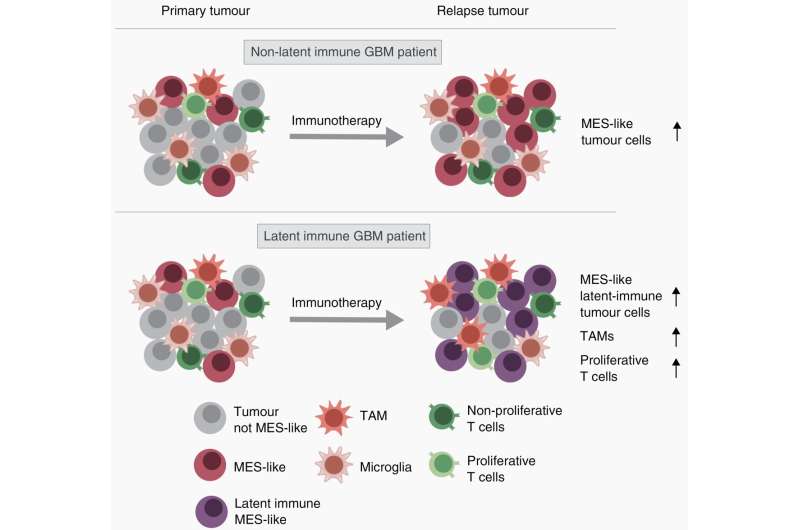This article has been reviewed according to Science X's editorial process and policies. Editors have highlighted the following attributes while ensuring the content's credibility:
fact-checked
trusted source
proofread
Study identifies mechanism behind glioblastoma's immunotherapy resistance

The cells of a rare, deadly cancer are resistant to immunotherapy. Now researchers may have found the cause, paving the way for a new type of treatment.
Immunotherapy is a medical success story, as it enables doctors to treat and sometimes even cure cancers that used to be fatal.
This does not apply to all cancers, though. The aggressive brain cancer glioblastoma fights back. And up until now, researchers did not know why. So says one of the researchers behind a new study from the University of Copenhagen.
"By mutating—that is, changing their DNA—cancer cells can become treatment resistant. However, glioblastoma tumor cells behave differently when subjected to immunotherapy," says Clinical Professor and Team Lead at the Biotech Research and Innovation Center (BRIC) Joachim Lütken Weischenfeldt, whose new study, published in Neuro-Oncology, describes tumor cells' response to immunotherapy.
Every year, about 300 Danes are diagnosed with the rare cancer glioblastoma. "By examining and comparing tumor material from before and after treatment with immunotherapy we were able to identify a group of patients in whom the appearance of the tumor cells had changed. The cells had simply put on a different 'overcoat,'" Joachim Lütken Weischenfeldt explains.
Instead of mutating—an often lengthy process that requires changing the cell's DNA—the tumor cells simply changed the way they look and behave.
"These cells—being able to change their appearance and resemble a particular type of cell found in bone marrow—are extremely plastic," Weischenfeldt explains.
"But the cancer cells were not the only cells to undergo change. We also saw significant changes in the macrophages and T-cells that surround and usually help kill the cancer cells."
Untreated, cancer cells are usually able to protect themselves from T-cell attack. Immunotherapy prevents them from doing so.
"In the glioblastoma patients, immunotherapy didn't render the cancer cells unable to protect themselves from T-cell attack. Our results suggest that they are able to assail the T-cells with signals and thus 'exhaust' them," said Weischenfeldt.
In other words, glioblastoma cancer cells are able to circumvent immunotherapy by changing their appearance, rendering the treatment ineffective, and to protect themselves from T-cell attack by exhausting the T-cells.
This combination makes glioblastoma cancer resistant to immunotherapy and the body's natural defense mechanisms, and this makes it a very aggressive type of cancer.
Rare, but fatal type of cancer
"Glioblastoma is the most aggressive type of brain tumor found in adults with short-term survival. So we desperately need new, effective treatment methods," says Weischenfeldt.
He hopes the new study will pave the way for new treatments capable of fighting the glioblastoma cancer's unique resistance mechanisms.
"When these tumor cells change their appearance, they express various proteins. And as these proteins will be unique to these cells, it should be possible to target them," he concludes.
This would mean using the glioblastoma cancer's tricky defense mechanisms against it. It will be a while before such treatment is available to patients, though.
"Developing treatment that only targets a specific type of cancer cell is tricky. So, it will take some time before we have found the right balance and are able to fight the tumor without causing major side effects," Weischenfeldt explains.
The next step for Weischenfeldt and his colleagues is to try to identify other plastic cancers, where treatment failure cannot be fully attributed to genetic mutations.
"Conceptually, this study proposes a different approach to cancer treatment. The idea is to target the cancer cells' plasticity, that is, their ability to change their appearance and interact with surrounding cells, including T-cells and macrophages.
"This could be the first step towards a more customized form of treatment for patients with aggressive cancers like glioblastoma for which we desperately need new treatment methods."
More information: Josephine D Hendriksen et al, Immunotherapy drives mesenchymal tumor cell state shift and TME immune response in glioblastoma patients, Neuro-Oncology (2024). DOI: 10.1093/neuonc/noae085




















